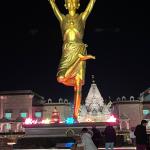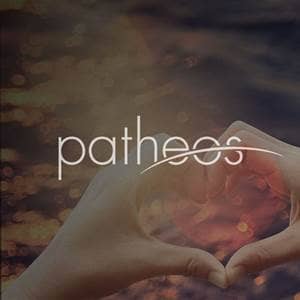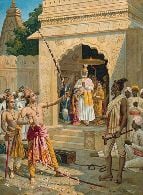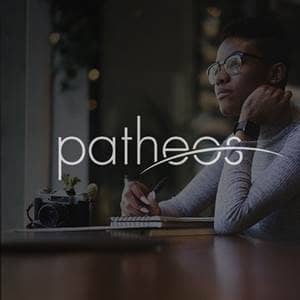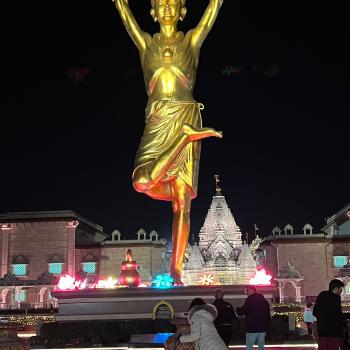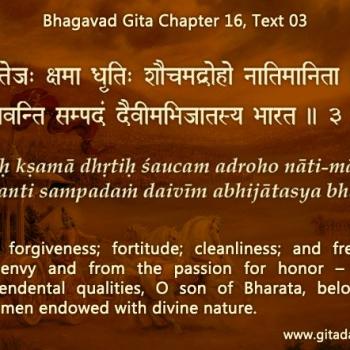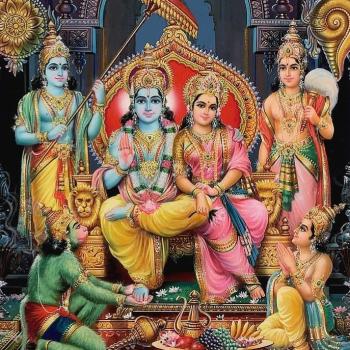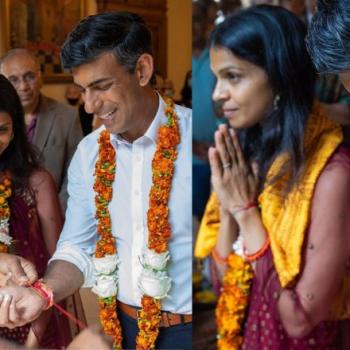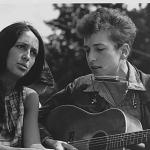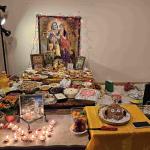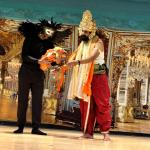The Govardhan Puja, Annakut, and Chhapan Bhog are intimately connected and observed on the day after Deepavali. These are associated with an ancient and legendary story from the times of Lord Krishna dating back to around 3,228 BCE. It is typical that most Hindu festivals connect us to our Divine roots.
This article includes the brief history and significance of these festivals followed by how the local Hindu community celebrated them. Most Hindu festivals offer food to God and once blessed, it is consumed as ‘Prasad.’
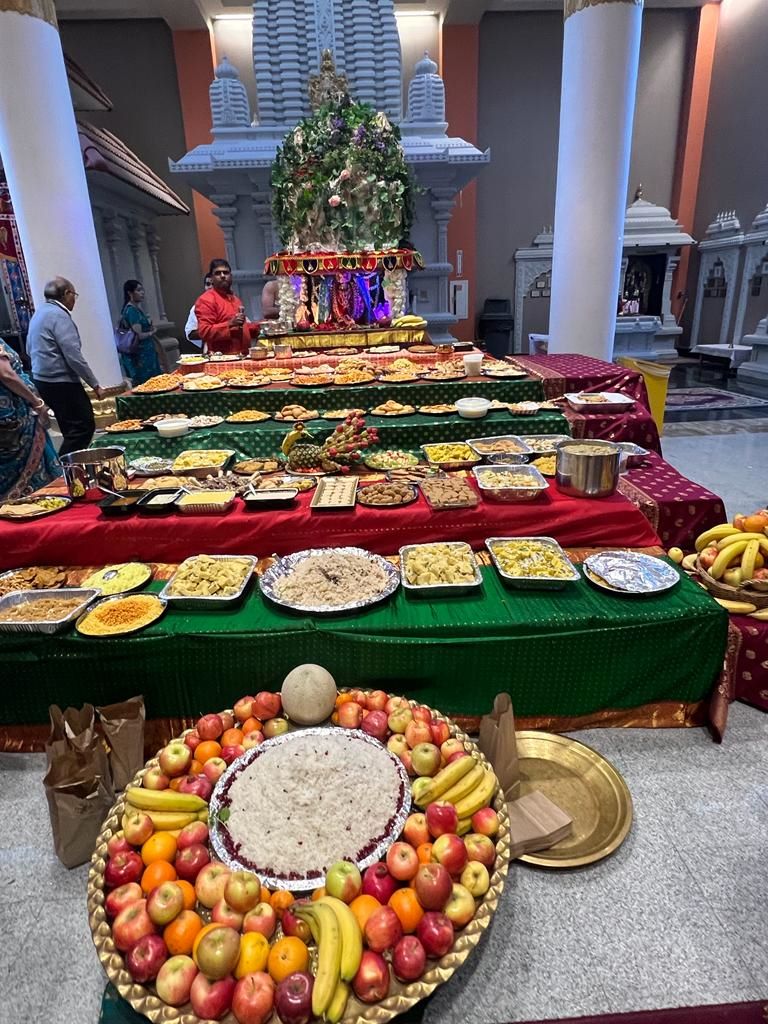
Govardhan Puja
Govardhan is a mountain located in Gokul, near Mathura, in the State of Uttar Pradesh. Lord Krishna spent his childhood there and performed Divine acts (seem like miracles) even as a child. Hindu scriptures call it Bal Leela (child’s acts).
Once Krishna asked his mother Yashoda why people offered prayers to Indra Dev (the rain God). Mother Yashoda said that Indra provided adequate rain for the harvest for people’s livelihood and therefore they made offerings to him. Krishna disagreed and said that Govardhan was a significant part of the landscape and provided natural resources including the rain cycle. He asked everyone to pray/make offerings to Mt. Govardhan. This infuriated Indra who in turn ordered torrential rainfall to drown Gokul.
The worried people of Gokul asked Krishna to protect them. Thus, with his Divine power, Krishna (as a child) lifted Mt. Govardhan on his little finger as an umbrella to protect human beings and animal kingdoms. Indra Dev realized that Krishna was an incarnation of Lord Vishnu and ceased the rain. Such is the story about one of many Divine acts by Lord Krishna earning him reverence in and around Gokul.
Annakut
Krishna’s mother and the people of Gokul were concerned that he had not eaten for seven days. When the rains abated, people called for a celebration. Every household in Gokul brought a large quantity and variety of food and delicacies to offer their gratitude to Krishna. The “mountain of food” is known as Annakut and Hindus have celebrated it ever since.
Chhappan (56) Bhog
Another legend is that Krishna’s mother (Yashoda) used to feed him eight times a day and Krishna, while holding Mt. Govardhan, had not eaten for seven days. Thus, 8×7=56 (Chhappan or fifty-six)) of Krishna’s favorite dishes were prepared for the celebration. The delicacies included milk products, rice preparations, savory snacks, fruits, nuts, dry fruits, pickles, and other cooked greens.
The Chhapan Bhog is also customary on Janmashtami, the birthday of Lord Krishna. Important to note is that “56” is not set in stone but it signifies the abundance and collective efforts of the community. The author believes that today’s potluck concept is similar in that people bring one or more dishes and everyone shares.
Author’s Observations:
Growing up, the author’s family observed Govardhan puja to honor Lord Krishna as well as to be thankful for the plentiful harvest. Typically, Mt. Govardhan was created using cow dung and the ceremony included sugar cane, an important cash crop for the farmers. Without a doubt, the festival meant the preparation of different and delicious food offered to God and shared with the family and friends.
It is important to note that Bharat (that is India) is a strong agricultural economy and thus the age-old celebration of food and harvest has deeper meaning. The author wonders if the celebration of harvest in the age-old Hindu Annakut is similar to the Thanksgiving in the United States when people express gratitude for food/harvest.
Govardhan Puja/Annakut in the United States
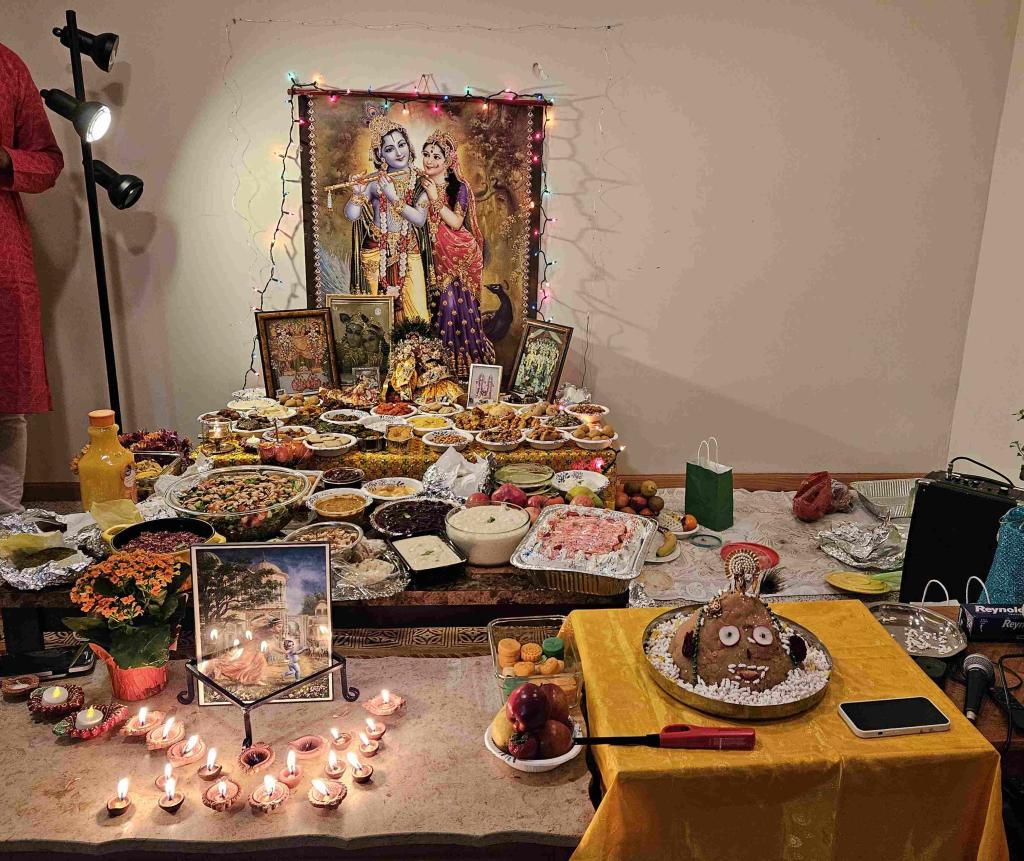
The abundance of food and higher-than-average prosperity of the hard-working Hindu professionals in the United States has taken the celebration of the Govardhan Puja/Annakut festival to a very different scale and magnitude. We discuss three different celebrations by the local community in the Twin Cities.
A Family Celebration of Govardhan Puja:
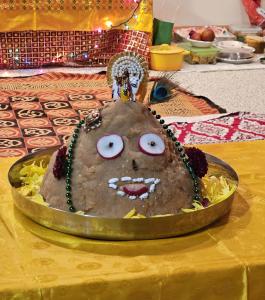
A devout believer of Lord Krishna invited about a dozen families for Govardhan puja. The host created Mt. Govardhan, shown on the left, with Halua (a traditional homemade sweet dish offered during Hindu puja). The story of Lord Krishna’s divine act was narrated. It was followed by waving a lighted “diya” with a wick before the sacred Govardhan Bhagwan. Then, everyone performed parikrama (circling around) of Mt. Govardhan seven times. It signified one circle for each day when Lord Krishna was holding Mt. Govardhan on his finger.
The Annakut with Chhappan Bhog was not necessarily by design but due to the devotion of visiting families. Incidentally, there were 58 dishes, a mix of dishes prepared by the host and dozens brought by the families. These delicacies included Indian desserts, savory and salty food, fruits, nuts, cakes, cookies, rice pudding, and more. Following the offering of Annakut to Bhagwan Krishna, everyone had dinner and enjoyed the Annakut delicacies. The abundance of Annakut food prompted the host to ask everyone to take food home. In Hindu culture, food wastage is strongly discouraged, particularly, if it has been offered to God.
Annakut at the Hindu Places of Worship:
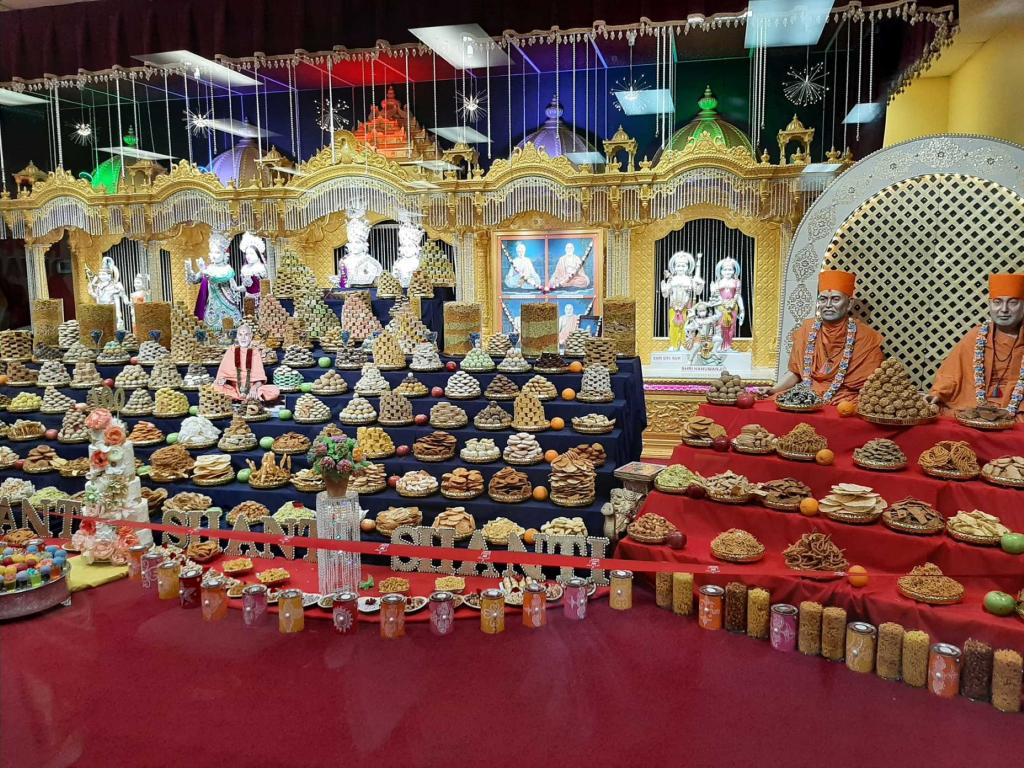
The Minneapolis-based BAPS mandir in 2022 and Akshardham in 2023 drew a large number of worshippers during the author’s visit to Annakut. The abundance and variety of food prepared by the devotees symbolized their devotion. The display of sweet and savory delicacies (photo above) was attractive and mouthwatering. The author had never seen so many dishes displayed in one location; a spectacle worth admiration.
Annakut at the Hindu Mandir was celebrated by hundreds of devotees with a similar enthusiasm. The food (photo on the top) was brought by the devotees to offer their gratitude to God. Other Hindu places of worship observe Annakut with their devotees.
Traditionally, the Annakut food is served to the devotees and/or shared with them to bring it home. For example, Akshardham offered us a sumptuous snack meal after the tour. Similarly, meals were served and a box of desserts (as Prasad) was given in Minneapolis.
Hinduism Rennaisance: Modi in Mathura
What a coincidence that Bharat’s Prime Minister Modi visited Mathura, the birthplace of Lord Krishna, on November 23. It is both historical and political as well as the hallmark of the continuous revival of Hinduism. During Modi’s tenure, many Hindu places of worship have been renovated/reconstructed that were desecrated/destroyed by the Islamic invaders. For example, the Kashi Vishwanath corridor (Lord Shiva’s Mandir) is complete and Lord Ram’s Mandir, in his birthplace Ayodhya, is opening in January 2024. Similar plans are underway for a corridor in Lord Krishna’s birthplace. These efforts signify an unprecedented Hinduism renaissance in Bharat as well as around the globe.
DISCLOSURE: This article is not generated using Chat GPT or any form of Artificial Intelligence


